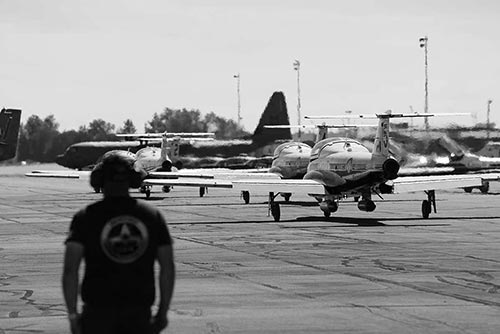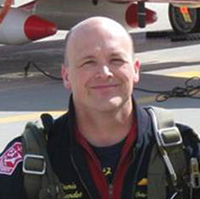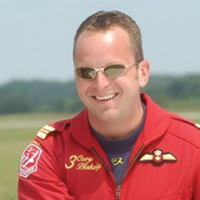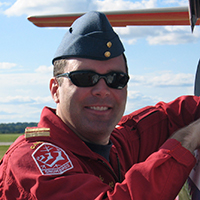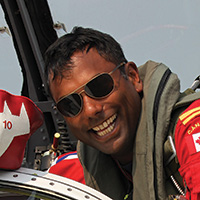Aces high

The day wasn’t supposed to end like it did
In the crisp morning air of Dec. 10, 2004, Capt. Chuck Mallett (retired), a Mount Royal Aviation diploma graduate, and Capt. Miles Selby strapped into their Tutor jets and headed south over the snow-covered and wind-swept Saskatchewan prairie to their practice area — the airspace over Mossbank, an abandoned Second World War airfield.
Just as on any other training day, the plan was to ascend, practice their manoeuvers as members of Canada’s elite Snowbirds aerobatic demonstration team, return to base and debrief. Mallett had three years under his belt as a Snowbird, and Selby two. Both held coveted solo pilot roles in the demonstration team, made up of nine aircraft.
As the two worked through their routine, they came to the top of a loop from opposite directions. Suddenly, when they should have been safely separated by at least 10 metres, they were on a collision course. Closing the gap at hundreds of kilometres per hour the two aircraft collided, bursting into a combined fireball 1,000 metres above the ground.
Selby was killed instantly. Somehow Mallett was miraculously thrown clear of the disintegrating aircraft. Through quick thinking and with thanks to his extensive training, he was able to open his parachute, separate from his bulky aluminum seat and descend to safety with only relatively minor injuries.
“I was extremely fortunate to have survived in the first place, so of course I feel lucky to be alive,” recounts Mallett.
“I was devastated by the loss of my friend and have wondered ever since what I could have done differently to change the outcome.”
For the Snowbirds, a tight-knit group of pilots, maintenance crew and support staff, the incident was crushing. But they regrouped, and learned from the experience. Through their commitment to each other and their craft, they held together and continue to delight audiences and instil patriotic pride throughout Canada.
WORTH THE RISK?
The summer of 2016 was a tough one for the air show community. In June, a member of the United States Navy’s Blue Angels died when his F-18 jet fighter crashed on takeoff. In a separate incident the same day, a member of the United States Air Force Thunderbirds had to eject (safely) from his F-16 jet. In July, a civilian stunt pilot performing at the Cold Lake Air Show was killed when his T-28 aircraft crashed. And in August, another aerobatic performer died when his vintage Stearman biplane impacted the ground while he was performing at the Airshow of the Cascades in Madras, Ore.
So is performing in the skies with eight other pilots in tight formation worth the risk that something could go wrong?
“We all mitigate risk in our daily lives,” says Maj. Denis Bandet, Aviation diploma, 1997.
“We calculate the risk driving to and from work … when we play sports, travel and even when deciding which foods to eat. We recognize the risk, plan for contingencies and work with safety in our minds.”
For the Snowbirds, where the margin of error is slim, safety is borne out of trust in each other and in their equipment, and built on brutal honesty — no matter where they are flying.
“Ego kills. You must be confident in your knowledge and skills, but not falsely overconfident for the sake of those around you,” explains Maj. Cory Blakely (retired), who earned his Mount Royal Aviation Diploma in 1991.
“At the end of the day, you are the one responsible for the aircraft and those in it. It is a daunting responsibility and one deserving of respect.”
Having experienced the worst possible outcome, yet still able to talk about it, Mallett understands that being a pilot comes with an element of risk, no matter what the aircraft or with whom he is flying.
“But I mitigate that risk during planning by imagining what could go wrong — hoping to be more prepared for an unusual situation should one arise.”
Bandet adds, “It’s difficult to measure the success of the Snowbirds, but there are entire generations of military members that have a story relating back to when they saw their first air show fly past or saw a Roundel sitting on a ramp. They’ll tell you that’s part of the reason they joined.
I’d say it’s worth it.”
LEARNING TO FLY
Since 1970, more than 1,200 pilots have graduated from the Aviation program at Mount Royal. For current Chair Leon Cygman, it’s no surprise many of them have gone on to military flying careers.
“Our graduates have taken jobs in commercial aviation and worked their way up to regional, national and international carriers, but the Snowbirds are the best of the best.
“It is a testament to our program that a handful of our graduates have made it to that level.”
While the military’s demand for aviators has ebbed and flowed over the years, in the mid-’90s the Canadian Armed Forces paved a path for young pilots to pursue their dreams of elite flight. Several flying colleges across the country — including Mount Royal — offered the starting point. Students could apply for the military and if they were successful, the fees for their second year of aviation school were covered.
Mount Royal graduates earn a Canadian commercial pilot licence with night, multi-engine and instrument accreditation. In the ‘90s, the new military officers of the contingent could then bypass primary flying training and move directly on to jet training at 15 Wing Moose Jaw, also home of the Snowbirds.
Blakely initially discovered flying through the Royal Canadian Air Cadets, getting aloft in gliders and then achieving his pilot’s licence while still in high school. Although he tried a stint at the University of Alberta, he says that,“ studying for the sake of studying,” did not appeal to him. At the urging of a friend, he enrolled at Mount Royal.
Timing was everything for Blakely and many other Mount Royal graduates who ended up in the military.
Blakely reached the “best of the best” status when he was invited to join the Snowbirds in 2003. Not everyone who’s invited to try out for the team makes it, but he did. Training is rigorous and involves a degree of precision flying that most pilots can’t dream about, let alone perform. Without the aid of computers or complex electronics, it is all eyes, hands and feet.
“I have never been so highly trained and proficient at anything in my life,” says Blakely.
“The experience can teach you a lot about yourself and a lot about other people.”
Capt. Greg Mendes’ approach to learning to fly was an ambitious one. While studying for his Bachelor of Science at the University of Calgary, he scheduled science classes and flying lessons on opposite days so he could fit in both.
“I’d bounce back and forth between the University (of Calgary) and (Mount Royal) College, and was also driving out to Springbank to do my flying.
“I was able to complete the two-year diploma and the last year of my degree simultaneously.”
Mendes served four tours in Afghanistan as a Hercules transport pilot before getting the call to become Snowbird 10, the show’s safety pilot and narrator, for two seasons in 2014 and 2015.
For Bandet, flying with the Snowbirds was never his goal, nor did it seem within reach. He says, “The experience that the team required seemed unattainable.”
Yet, with the encouragement of one of his former instructors, he took another look.
“What impressed me the most was how everyone worked in perfect sync. The entire team — from the maintainers to the team lead — were 100 per cent professional and personable.
“I was hooked and from that point on, I knew that I wanted to fly with them.”
In 2011, Bandet was honoured to be added to the team, flying for three seasons before stepping down to return to being a fighter pilot.
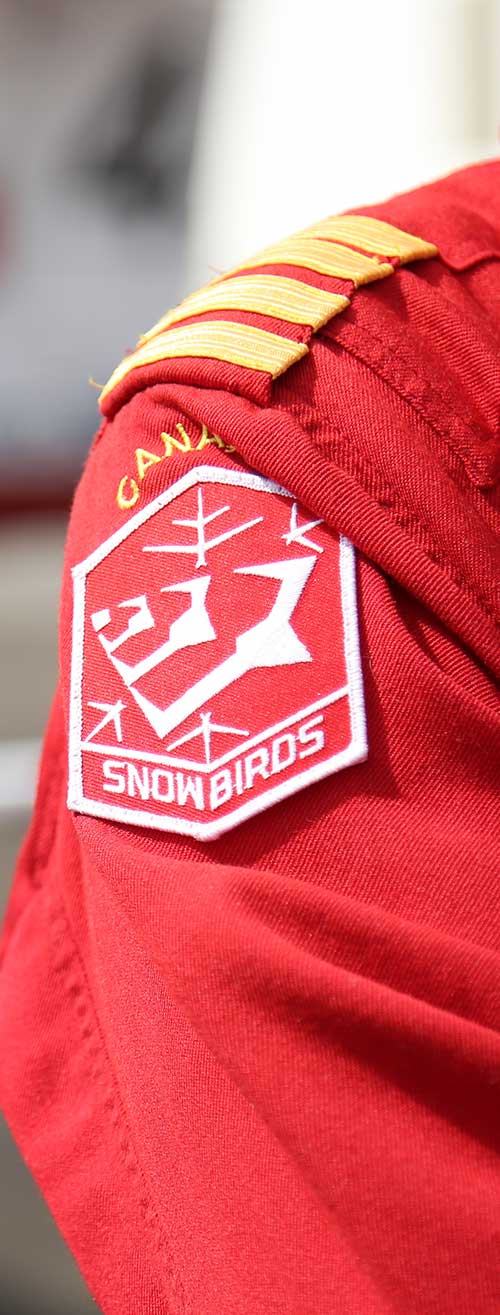
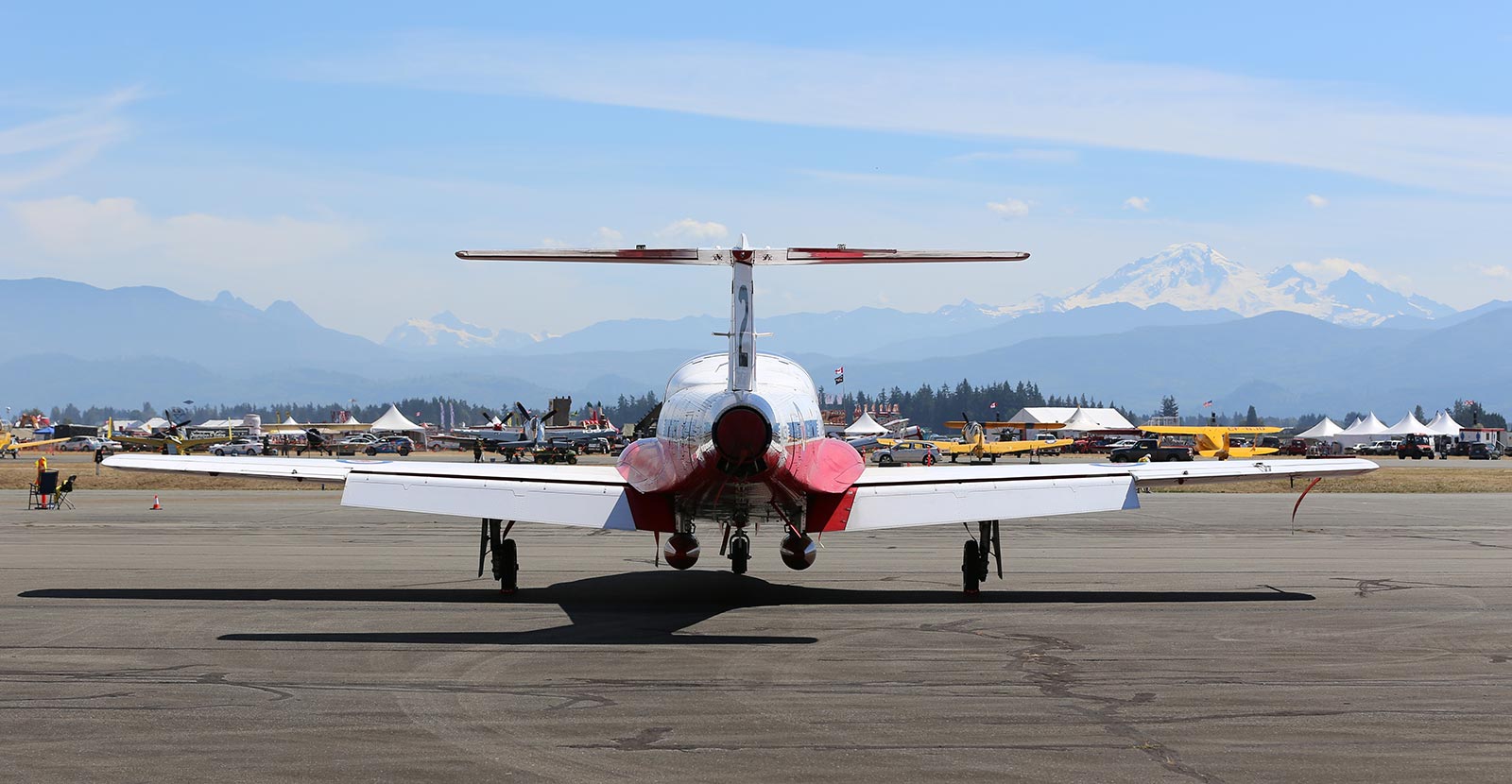
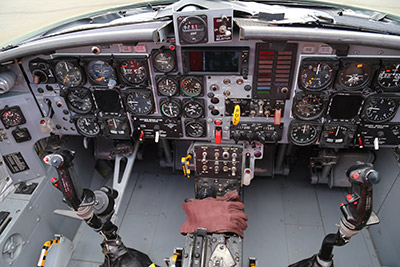
Canada has only 22 CT-114 Tutor aircraft left in its fleet, with the last few manufactured in 1966. Without the aid of computers and complex electronics, the Snowbirds fly using their eyes, hands and feet.
THE LITTLE PLANE THAT CAN…AND DOES
Flying in a nine-aircraft aerobatic team in the CT-114 Tutor, a small, subsonic jet trainer, at speeds of up to 590 km/h, often only 1.2 metres apart, requires high standards, extreme attention to detail and, of course, nerves of steel.
“The Tutor is a wonderful aircraft,” says Mendes.
Bandet agrees, adding, “Who knew that a jet that was designed with a slide rule would still be flying today?”
Getting old even by aviation standards, the Tutor was designed and built in Canada in the 1960s. The jet was last manufactured in 1966 and retired from training service in 2000, leaving only a handful left to supply the Snowbirds. Despite this, the accidents the team has experienced have had little to do with the serviceability of the aircraft.
Maintenance crew fly to each show with their assigned pilots. It is their job to squeeze every last flying minute out of each part.
According to the commanding officer of the Snowbirds, Lt. Col. Brad Wintrup (whose call sign is “Squid”), engineering work needs to be done to extend the life of the remaining 22 Tutors in Canada’s fleet to potentially reach 2025 or 2030.
“In the meantime, the aircraft has an expiration date of 2020,” he says.
Until then, resting on the Tutor’s stout, 11-metre wingspan is the pride of a nation.
“One only needs to stand on Parliament Hill on Canada Day and breathe in the national pride when the Snowbirds fly over to understand,” says Blakely.
CT-114 Tutor
Crew: 2
Length: 9.75 m
Wingspan: 11.12 m
Height: 2.84 m
Empty weight: 2,575 kg
Power: General Electric J85-CAN-40 turbo jet
Thrust: Reaches 5,500 metres in less than six minutes and can do sustained 2G turns at 7,600 metres
Maximum speed: 741 km/h
Range: 648 km
Service ceiling: 11,850 m
Data from the
Royal Canadian Air Force
Backstage Access
Summit writer Dave McLean and photographer Michal Waissmann gained exclusive access to “backstage” before the Snowbirds took to the skies at the Abbotsford International Airshow.
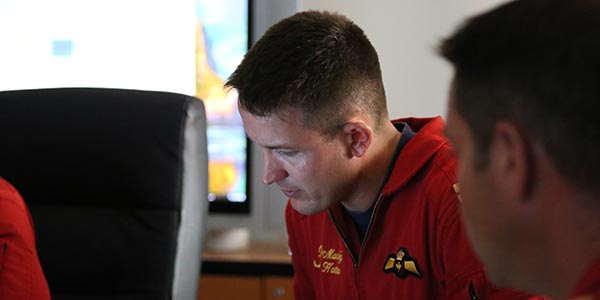
“We didn’t become a national treasure by being average,” declares Maj. Indira Thackorie, the Snowbirds public affairs officer, as she briefs a small group of friends and family members moments before taking them into a closed-door team meeting at the Abbotsford International Airshow in August.
Inside the small conference room the mood is light, even fun.
In the background, Snowbird 3, Capt. Maciej “Match” Hatta (a.k.a. @the7jet) is editing the latest team video to post later on social media. They are a media savvy group, often interacting with fans near and far from their smart phones.
In 2016, this is not your father’s version of the Snowbirds. Instead of a flying routine set to the tones of some long-forgotten piano opus from the 1980s, the team now dances through the air to well-known pop, rock and hip-hop tracks.
And every year the team puts together a slightly different show that consistently pushes the limits of their 50-year-old Tutor jets.
As the seconds tick down to the team’s debrief of the previous evening’s performance, the tone in the room begins to turn serious. Snowbird 1, or “Boss”, Maj. Yanick “Crank” Grégoire easily takes full command of the room to set the stage.
Every single show the Snowbirds perform is recorded and dissected move by move. During the debrief, each pilot makes note of something they did wrong and pledges a modest amount to the kitty — a fiver for a small mistake. But when there’s another jet team in town, as there is in Abbotsford, it’s double.
“That’s $20 for smoke off when it should have been on and smoke on when it should have been off,” says one of the guilty parties.
A flurry of technical terms bounce about the room, such as “dish top roll” and “skating front side.” They know exactly what went wrong, and right. The mood is deeply professional as they analyze each twist and turn. For today at least, it is relaxed, as the team performed a nearly flawless show the night before.
“Snowbirds, split, now,” the Boss is heard saying through his oxygen mask mic on the videos.
“Niiice!”
The group lets out a congratulatory cheer as they witness the perfect symmetry of last night’s Maple Split.
It’s a careful mix of self-critique and comfortable laughter among this tight-knit group. After each manoeuver, they pause, discuss and resume, picking apart the routine second by second. They are only as good as their last performance and each debrief is a chance to get better.
At one point, Grégoire stops the video to ask his number 4, “How were you with that turn?”
He responds, “It was probably the most aggressive one I’ve flown all year.”
With the debrief done, the team moves on to the mission ahead, preparing for the next show only half an hour away. Each member of the team from the Boss to the narrator, picks his or her own mission goal.
And then, they run through the entire 27-minute show. Out loud. By memory. A nearly unbelievable and imaginably taxing feat.
For most of the routine, save for the team soloists, it is Boss who does the talking. But when he utters the words, “Snowbirds, split, now,” a chorus of other team members can be heard saying loudly: “S in split!” “N in now!” “P in pause!”
At the conclusion of the briefing, the team gets ready to head out to the jets where their technicians await. Before long, the members are taxiing towards the runway to perform for adoring crowds, again.
The routine is the same for upwards of 60 shows a year. But if you think it seems tedious, Mount Royal alum Chuck Mallett explains, “Think of it this way. You get paid to go on a road trip for six months every year with a dozen of your closest friends. You all get your own vintage sports car maintained in pristine condition by your crew who fly with you.
“The job itself is challenging but really fun, and every time you do it you get to be a minor celebrity for a few minutes. Not a bad deal at all.”
Read more Summit
Changing skies
75 years after the Royal Canadian Air Force opened a trio of runaways at MRU, the University remembers our Garrison roots
READ MORE


